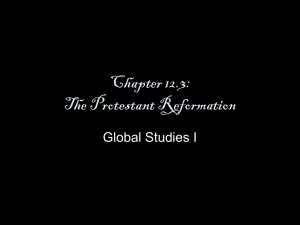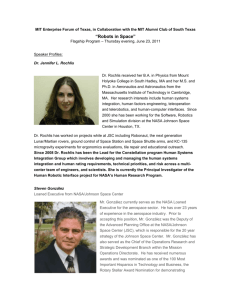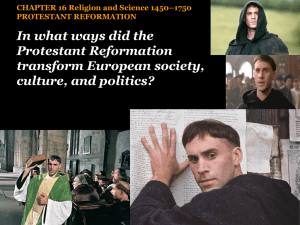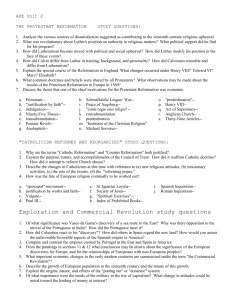COS 312 Theological Heritage: The Reformation Date
advertisement
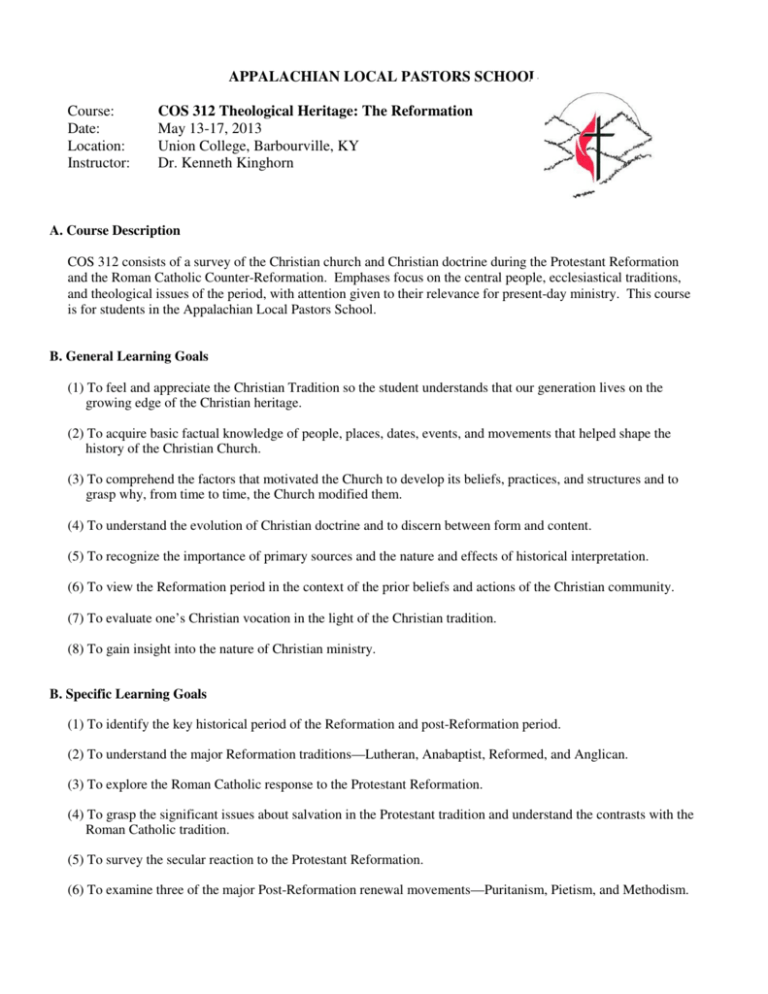
APPALACHIAN LOCAL PASTORS SCHOOL Course: Date: Location: Instructor: COS 312 Theological Heritage: The Reformation May 13-17, 2013 Union College, Barbourville, KY Dr. Kenneth Kinghorn A. Course Description COS 312 consists of a survey of the Christian church and Christian doctrine during the Protestant Reformation and the Roman Catholic Counter-Reformation. Emphases focus on the central people, ecclesiastical traditions, and theological issues of the period, with attention given to their relevance for present-day ministry. This course is for students in the Appalachian Local Pastors School. B. General Learning Goals (1) To feel and appreciate the Christian Tradition so the student understands that our generation lives on the growing edge of the Christian heritage. (2) To acquire basic factual knowledge of people, places, dates, events, and movements that helped shape the history of the Christian Church. (3) To comprehend the factors that motivated the Church to develop its beliefs, practices, and structures and to grasp why, from time to time, the Church modified them. (4) To understand the evolution of Christian doctrine and to discern between form and content. (5) To recognize the importance of primary sources and the nature and effects of historical interpretation. (6) To view the Reformation period in the context of the prior beliefs and actions of the Christian community. (7) To evaluate one’s Christian vocation in the light of the Christian tradition. (8) To gain insight into the nature of Christian ministry. B. Specific Learning Goals (1) To identify the key historical period of the Reformation and post-Reformation period. (2) To understand the major Reformation traditions—Lutheran, Anabaptist, Reformed, and Anglican. (3) To explore the Roman Catholic response to the Protestant Reformation. (4) To grasp the significant issues about salvation in the Protestant tradition and understand the contrasts with the Roman Catholic tradition. (5) To survey the secular reaction to the Protestant Reformation. (6) To examine three of the major Post-Reformation renewal movements—Puritanism, Pietism, and Methodism. 2 C. Texts (YOU CAN LIKELY FIND USED COPIES OF THESE TEXTS ON THE INTERNET) 1. Bainton, Roland H., The Reformation of the Sixteenth Century, Boston: The Beacon Press, 1952. 2. Bettenson, Henry, ed., Documents of the Christian Church, second edition, London, New York: Oxford University Press, 1963. (Read assigned selections) 3. González, The Story of Christianity, vol. 2, The Reformation to the Present Day, San Francisco: Harper & Row, 1984. 4. Kerr, Hugh T., ed., Readings in Christian Thought, Nashville: Abingdon Press, 1966. (Read assigned selections) 5. Noll, Mark A., Turning Points: Decisive Moments in the History of Christianity, 2nd ed., Grand Rapids: Baker Academic Books, 2000. (This book will also be used in COS 312.) D. Session Guidelines 1. Martin Luther: The Man and His Message READ GONZÁLEZ, 6-20 READ KERR, 136-140 READ BAINTON, 3-35 2. The Indulgence Controversy and Luther’s Ninety-five Theses READ GONZÁLEZ, 20-28 READ BETTENSON, 182-192 READ BAINTON, 36-56 READ BETTENSON 182-201 READ NOLL, 151-174 3. Luther’s Legacy and Final Years 29-45 READ KERR, 140-154 READ BAINTON, 57-76; 141-159 READ BETTENSON, 201-206 READ GONZÁLEZ, 4. The Anabaptists READ GONZÁLEZ, 53-60 READ KERR, 179-182 READ BAINTON 95-109; 123-140 5. The Reformed Tradition: Zwingli and Calvin READ GONZÁLEZ, 46-52; 61-69; 86-109 READ KERR, 157-169 READ BAINTON 77-94; 110-122; 160-182 READ BETTENSON, 212-217; 268-269 6. The English Reformation READ GONZÁLEZ, 70-85 READ KERR, 172-174 READ BAINTON 183-210 READ BETTENSON, 217-244 READ, NOLL, 175-196. 3 7. The Roman Catholic "Counter-Reformation" READ GONZÁLEZ, 110-124; 174-171 READ KERR, 175-179 READ BETTENSON, 258-268; 269-271 READ NOLL, 197-222. 8. The English Puritans READ GONZÁLEZ, 149-163; 172-174 READ BETTENSON, 244-256; 282-311 READ KERR, 182-190 9. The Enlightenment and the Age of Reason READ GONZÁLEZ, 132-148; 185-195 READ KERR, 206-233 READ BETTENSON, 268-271; 311-315 READ NOLL, 245-268. 10. The Wesleyan Revival in England READ GONZÁLEZ, 209-16 READ BETTENSON, 256-258 READ KERR, 190-196 READ NOLL, 222-244 E. Class Assignments 1. Before class begins, read the assigned readings above. 2. Before the class begins, prepare two papers, double-spaced, about six pages in length. First paper: Explain Martin Luther’s teaching on (1) sola scriptura (scripture alone (2) sola gratia (grace alone), (3) sola fide (faith alone), and (4) solus Christus (Christ alone). Apply the theology of these landmark Reformation doctrines to the needs and opportunities in your denomination. Second paper: Discuss the doctrines of original sin, election, and the final perseverance of the saints as taught by the Council of Trent (Bettenson, pp. 261-268; Kerr, pp. 175-178; (González, pp. 119-121), John Calvin (Bettenson, pp. 212-214; Kerr, 164-168; González, pp. 179-183), and Wesleyan-Arminianism (Bettenson, pp. 268-269; Kerr, 193-195; González, pp.179-183). On this point, which doctrinal system do you embrace? Why?


